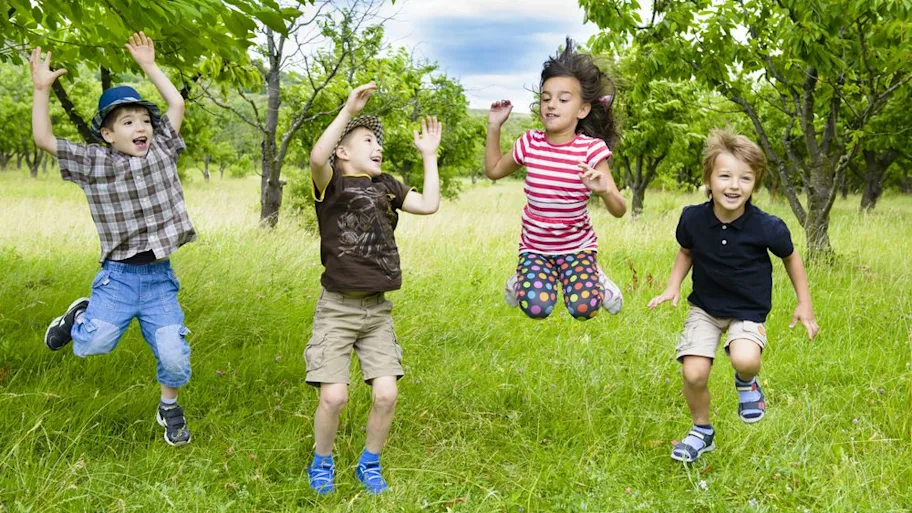
- Science news
- Featured news
- Footwear habits influence child and adolescent motor skill development
Footwear habits influence child and adolescent motor skill development

Habitually barefoot children score significantly higher in balance and jumping tests compared to habitually shod children.
Researchers show that regular physical activity without shoes may improve children’s and adolescents’ balancing and jumping skills
— by Marissa Land, Frontiers science writer
New research finds that children and adolescents who spend most of their time barefoot develop motor skills differently from those who habitually wear shoes. Published in Frontiers in Pediatrics, this is the first study to assess the relevance of growing up shod vs. barefoot on jumping, balancing and sprinting motor performance during different stages of childhood and adolescence. The study shows that habitually barefoot children are noticeably better at jumping and balancing compared to habitually shod children, particularly from 6-10 years of age. While these beneficial barefoot effects diminished in older adolescents, the research nevertheless highlights the importance of barefoot exercise for motor development as children grow and mature.
Motor Skills of Children and Adolescents Are Influenced by Growing up Barefoot or Shod► Read original article► Download original article (pdf)
“Walking barefoot is widely thought to be more natural, and the use of footwear has long been discussed as an influencing factor on foot health and movement pattern development,” explains Professor Astrid Zech from the University of Jena, Germany, who led the study.
“A few studies report that barefoot situations change biomechanics in children and adults during running and jumping — but only limited knowledge exists for the clinical relevance of this finding,” she continues. “We wanted to investigate, for the first time, whether changes in foot biomechanics due to barefoot activities are actually relevant for the development of basic motor skills during childhood and adolescence.”
Zech, together with two research teams, assessed three motor skills — balance, standing long jump and a-20 m sprint — in 810 children and adolescents from 22 primary and secondary schools across rural Western Cape South Africa and urban areas of northern Germany. The two groups were selected to represent different footwear lifestyles: children from South Africa are habitually barefoot, while children from Germany wear shoes most of the time.
The habitually barefoot participants scored significantly higher in the balance and jumping tests compared to the habitually shod participants. This difference was observed in both test conditions (barefoot and shod) and across all age groups (6-10, 11-14 and 15-18 years), but particularly evident in 6-10 year-old children. The habitually barefoot children also performed better when barefoot than when shod.
“Most of the primary school children in our study (South Africa) go to school and perform sport and leisure activities barefoot,” says Professor Ranel Venter from Stellenbosch University, who led the South African research team. “Our finding that these children performed better in balancing and jumping supports the hypothesis that the development of basic motor skills during childhood and adolescence at least partly depends on regular barefoot activities.”
Related: Touchscreens may boost motor skills in toddlers
The results for the sprint test, however, were different. Here the habitually shod children performed better, particularly those in the 11-14 year age group, and both groups performed better while shod. The researchers explain that environment – the one factor that could not be standardized across the two study locations – may have influenced this result.
“In South Africa, the sprint test took place outdoors – with different weather conditions and surfaces. In contrast, the German children took the sprint test indoors, mostly in a sports hall with a sprung floor,” says Zech. “The type of shoe may also have influenced the results. South African students run in school shoes, while German students use sneakers or athletic shoes in their physical education classes. So while our results suggest that growing up shod may be beneficial for fast sprinting, we need to investigate this further.”
Overall, the researchers’ work emphasises the benefits of barefoot physical activities for motor development.
“Physical education classes, exercise and sport programs, and reactional activities that aim to improve basic motor skills could benefit from including barefoot activities,” says Zech. “Parents could also encourage regular barefoot time at home.”
Original article: Motor Skills of Children and Adolescents Are Influenced by Growing up Barefoot or Shod
REPUBLISHING GUIDELINES: Open access and sharing research is part of Frontiers’ mission. Unless otherwise noted, you can republish articles posted in the Frontiers news blog — as long as you include a link back to the original research. Selling the articles is not allowed.






